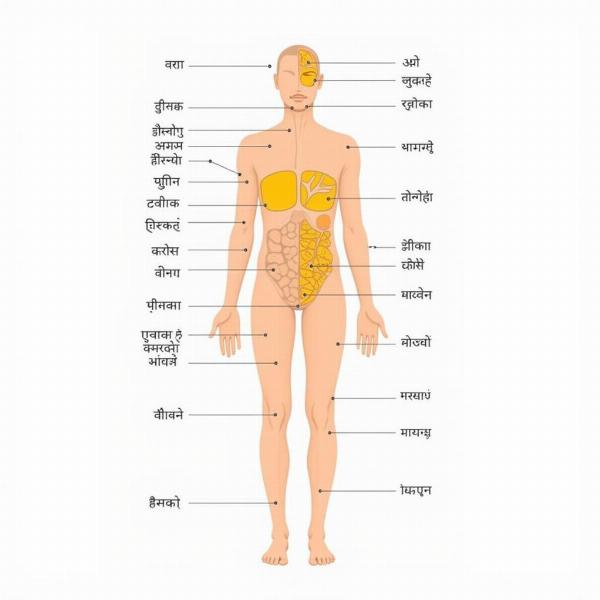Understanding the meaning of “angas” in Hindi can be nuanced, depending on the context. “Angas” (अंग) primarily translates to “body parts” or “limbs.” However, it can also refer to “parts” or “components” of something larger, like the “angas” of a machine or the “angas” of a story. This multifaceted nature of the word “angas” makes it essential to understand its various interpretations within Hindi language and culture.
Exploring the Different Meanings of Angas
The word “angas” holds a significant place in various aspects of Indian culture, from ancient texts to everyday conversations. Let’s delve deeper into its diverse meanings:
Angas as Body Parts
The most common understanding of “angas” is its reference to body parts. From head to toe, each part plays a vital role in our physical existence. Understanding the names and functions of these “angas” is crucial for communication, especially in medical contexts. For example, knowing the Hindi word for “hand” (हाथ – hath) or “leg” (पैर – pair), both considered “angas,” is essential for effective communication.
 Diagram of Human Body Parts with Hindi Labels
Diagram of Human Body Parts with Hindi Labels
Angas as Components or Parts
Beyond the physical body, “angas” can also denote the constituents of a larger entity. Think of the “angas” of a car – the engine, wheels, steering wheel, etc. Similarly, a story has its “angas” – the plot, characters, setting, and so on. This broader definition highlights the interconnectedness and interdependence of parts within a whole. Understanding this meaning allows for a deeper appreciation of complex systems and narratives.
Angas in Ancient Texts and Scriptures
In ancient Indian texts and scriptures, “angas” often carries symbolic or philosophical meaning. For instance, in yoga philosophy, the “angas” of Ashtanga Yoga represent eight limbs or stages on the path to self-realization. These “angas” include Yama, Niyama, Asana, Pranayama, Pratyahara, Dharana, Dhyana, and Samadhi. Understanding these “angas” is crucial for those pursuing this spiritual path.
How Context Influences the Meaning of Angas
Like many words, the precise meaning of “angas” depends heavily on the context. Consider the following examples:
-
“Mere sharir ke sabhi angas dard kar rahe hain.” (मेरे शरीर के सभी अंग दर्द कर रहे हैं.) – Here, “angas” clearly refers to body parts, as the sentence translates to “All my body parts are aching.”
-
“Is kahani ke angas bahut sundar hain.” (इस कहानी के अंग बहुत सुंदर हैं.) – In this case, “angas” signifies the components or aspects of the story, meaning “The elements of this story are beautiful.”
Angas: Beyond the Basics
Understanding the nuances of “angas” provides a deeper appreciation for the richness and complexity of the Hindi language. It allows for a more accurate interpretation of texts and conversations, fostering clearer communication.
Conclusion: Mastering the Meaning of Angas
“Angas,” while seemingly simple, embodies a range of meanings in Hindi. From physical body parts to components of larger entities and symbolic representations in ancient texts, “angas” reveals the intricate connections between language, culture, and thought. By understanding its various interpretations and contextual nuances, you can enhance your comprehension of Hindi and gain a deeper appreciation for its cultural significance.
FAQ: Common Questions about Angas
-
What is the plural form of “angas” in Hindi? The plural form is also “angas” (अंग).
-
Can “angas” be used to refer to internal organs? Yes, “angas” can refer to both external and internal body parts.
-
Is there a difference between “angas” and “sharir” (body) in Hindi? Yes, “sharir” refers to the entire body, while “angas” refers to individual parts of the body.
-
How do I know the correct meaning of “angas” in a sentence? The context of the sentence will usually clarify the intended meaning.
-
What are some other words related to “angas” in Hindi? Related words include “avayav” (अवयव – component), “hissa” (हिस्सा – part), and “gadan” (गठन – structure).
Meaning-Hindi.in: Your Partner for Accurate Hindi Translations
Meaning-Hindi.in is your one-stop solution for all your Hindi translation needs. We offer a wide range of professional translation services, including business and commercial document translation, legal and certified translation, technical and user manual translation, website and localization services, educational and academic document translation, express translation, and specialized translations. Our team of expert Hindi linguists ensures accurate, culturally sensitive, and high-quality translations tailored to your specific requirements. Contact us today for a free quote! Email: [email protected], Phone: +91 11-4502-7584. Let Meaning-Hindi.in help you bridge the language gap and achieve your communication goals.